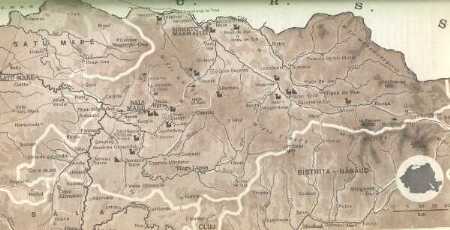



These Maramures County webpages are dedicated to Fred Fox of blessed memory, also known as Feibusch (Favish) FUCHS, who was born in Havas Mezo on March 15, 1886 and to his parents Benjamin (Benzion) Fuchs and Feiga BAUM and to his grandparents Israel BAUM/BOHM/BAIM and Rotsa FEIG who was a red-head. Grandpa emigrated on November 16, 1912 aboard the S.S.Kroonland and proceeded to Chicago where he later met and married Regina SALAMON on December 22, 1922 at Congregation Ahavas Achim on Claremont and Potomac Avenues. Grandpa loved the food and music of his beloved homeland, Romania. His favorite song was Kol Nidre as sung by Cantor Yosele Rosenblatt. He also loved "ROMANIA, ROMANIA" written by Aaron Lebedeff, a star of the Yiddish stage. Bubbe would make him "Mamaliga." Grandpa died on August 8, 1962 and is buried in the Maramaros section of Waldheim Cemetery in Chicago.


"Jews immigrated to Maramures because it was the only place in Europe they could own land, and it wasn't under the Romanians, but the Hungarians who possessed Transylvania (900 A.D to 1918). In 1918 the Allies gave it away to the Romanians, to punish the Hungarians for allying themselves with Germany." (Leslie Gyi)

Please note that all photos are the copyrighted property of the owner as designated below. Permission to reproduce or distribute them must be obtained from the owner.
 |

|
 |
|||
We went by car to Maramures from Budapest; it took almost 11 hours to reach Sighet, but I guess it can be done faster. We first spent two days in Sighet. The next three days we travelled east in Maramures county and visited numerous small villages, including Poienile-de-Sub Munte. The area is fascinating; it is travelling back in time. It is poor and very undeveloped, and in many aspects people live as if it was 1902 rather than 2002. But the landscape is fantastic; green hills, small rivers, fields and flowers. Poienile de Sub Munte was about 1.5 hours by car from Sighet where the road ends at the feet of some mountains. Although it is in the middle (or rather at the end) of nowhere, it is easy to understand why people settled there long time ago. It is a beautiful location; the soil is rich and the climate is good.(Kaj Fried, 2002)
"The Cemetery is situated 20 km from the main road, near the center of town, at the back of the big Orthodox Church. It is enclosed by a fence and there is a caretaker. The dimensions are about 150x50 meters. The Cemetery is on a 40 to 45 degree slope. There are about 300 gravestones, some of which are unreadable due to weathering." (Marcel Mindrescu, 2002)
"I must confess that although it was one of the smallest, least inhabited places I visited--maybe the weather was keeping people in that day--there was nevertheless something very attractive about Craciunesti. Of all the places I visited, it seemed the most "shtetl-like"; perhaps because it seemed least affected by the 20th century."
This town was originally composed of two different parts, Kisbocs-ko and Németbocsko.Today it is split into 2 villages on the left and right riverside of the Tisza, Velkij Bicskov/composed from Kis and Nagy Bocsko named Velkij Bicskiv too, and located in Ukraine, because the river is the borderline between Ukraine and Romania, and the former Német-bocsko became an independent town, named Bocicoiu Mare, be-longing to Romania. Dr. Prof A. Harmath
Would you like to connect with others
researching Maramures County?
Click a button to search
the JewishGen Family Finder database.
"The Jews of Poienile de Sub Munte (also known as Havas Mezo) were concentrated in the ghetto of Upper Vishva, established May 16-23rd, 1944, in the center of the city on the "Jewish Street" and on three other smallstreets leading from it. The crowding was insufferable, 20-30 people were quartered in one room. An attendance-roll-call line-up was held every day, sometimes lasting several hours. In the line-up there were also beatings. The food rations that were provided were very meager. Part of the men were taken for various labor-projects, especially wood-cutting. They were over-worked, while weak and starving. This ghetto contained about 13,000 souls. In addition to the 4,000 local Jews there were the Jews from Lower-Vishveh, Middle-Vishveh, Bursha, Bistra, Vishoi-Vilij, Lardine, Masif, Polien-Riskveh (Poienile de Sub Munte), P atriveh, Kriveh, and Riskveh. The Jews of this ghetto were deported to Auschwitz in 3 transports between the 17th-23rd of May, 1944."(The Marmaros Book, In Memory of a Hundred and Sixty Jewish Communities Edited by S. Y. Gross and Y. Yosef Cohen, Tel Aviv, Israel,1983, Page 33)

Copyright © 1999-2015 Cherie Lee Velen Korer
|